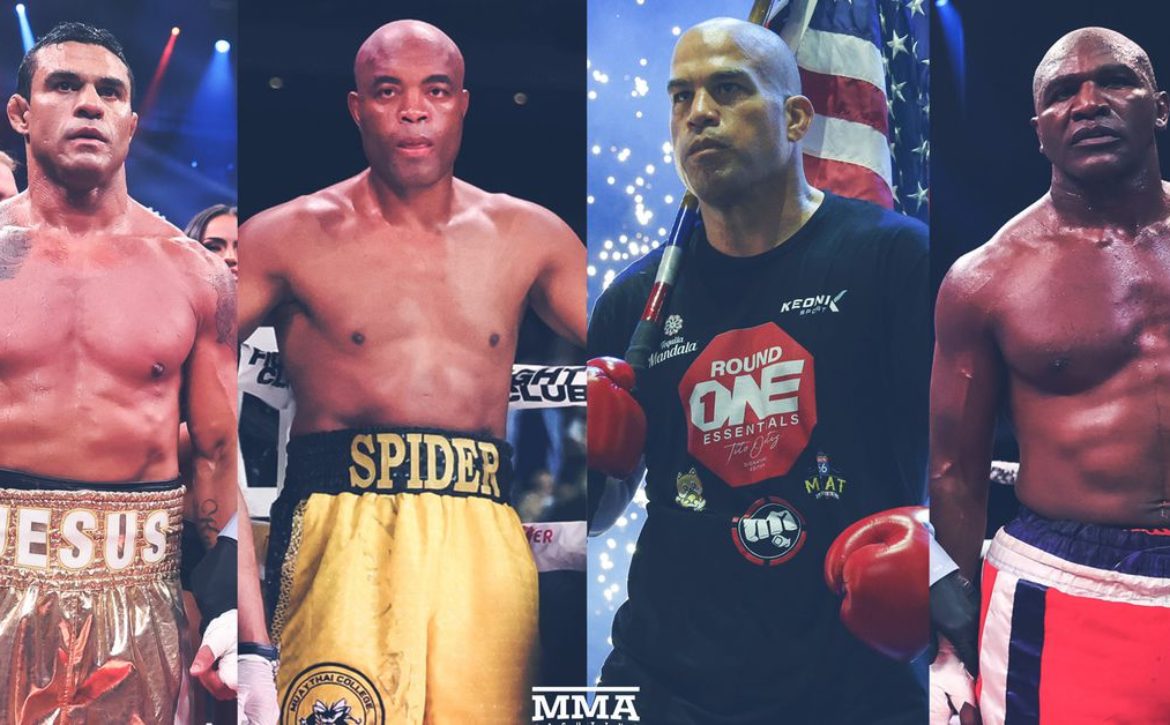
The Great Divide: Whose responsibility is it to protect fighters competing past their prime?
The Great Divide is a recurring feature here at MMA Fighting in which our staff debate a topic in the world of MMA — news, a fight, a crazy thing somebody did, a crazy thing somebody didn’t do, or some moral dilemma threatening the very foundation of the sport — and try to figure out a resolution. We’d love for you to join in the discussion in the comments below.
The question of what to do with the legends of combat sports as they enter their twilight years is not a recent conundrum. For years, fans have wondered how long we should allow our favorite fighters to hang on after they’ve parted ways with — and in some instances, been discarded by — the organizations where they became stars. If you have a name in this business, there’s always another chance to make a buck doing what you love just around the corner, and with the recent rise of special attraction (some might say “freak show”) boxing, our veterans have more avenues than ever through which to continue their careers.
This past weekend we saw a glimpse of what felt like the beginning of a new chapter in the careers of MMA legends Vitor Belfort and Anderson Silva, and what we hope is a wake-up call for Evander Holyfield and Tito Ortiz. Holyfield and Ortiz failed to make it out of the first rounds of their respective bouts, opening the door for a fresh wave of criticism and scrutiny as it pertains to how much autonomy older fighters should be allowed.
In short, does someone need to protect these fighters from themselves?
MMA Fighting’s Steven Marrocco and Alexander K. Lee give their take on what protocols need to be considered for the latest combat sports trend in this edition of The Great Divide.
REGULATORS HAVE TO MAKE THE TOUGH CHOICES
Marrocco: For the first time in a multi-decade boxing career, Evander Holyfield’s own children essentially told him not to fight.
“This is the first time my kids ever told me … ‘Dad, you don’t need to be getting hit,’” he told ESPN on Wednesday, before a Vitor Belfort 14 years his junior batted him around the ring until the ref mercifully stopped the punishment. Had the supposed protectors of health and safety been doing their jobs in Florida, Holyfield’s kids would’ve never had to have that conversation.
Holyfield believed he could defend himself and that Belfort wasn’t a threat. Considering his expertise and background, one couldn’t expect him to feel any differently. If he didn’t feel that way, he wouldn’t have given the world so many memorable victories. He wouldn’t be a three-time heavyweight champion. So it goes for most fighters, who spend their entire lives sharpening the same sword, reaching toward perfection, only to be the last ones to find out they should put it down to preserve what’s left of their lives — for their loved ones, and for the society that potentially bears the cost of their decisions.
Prizefighting creates a series of incentives that grow more lopsided as a fighter ages. As the rewards grow bigger, so do the risks to the brain and body. One of the cruelest things about the fight business is that the extent of the risks often don’t become apparent until decades later. Like any endeavor that involves imminent harm to life and limb, regulators are supposed to be there to stop participants before they do unnecessary harm to themselves. But all too often, they’re only serving as window dressings.
Most of the commissions that regulate combat sports around the world rely on fighters — the ones with the biggest incentives to misrepresent their health — to certify that they are fit to fight. They rely on the results of tests that may miss the signs of long-term brain trauma, or they make licensing decisions based on a single snapshot in time rather than in the context of history. There is still no national database of medical information to help a commission doctor get a full picture of a fighter’s health over time, and so, they frequently sign off when there are no obvious indications of long-term trauma. They miss the forest for the trees.
The thing that makes Holyfield’s case downright offensive to me is that you don’t need a degree in neurology to tell that he is suffering from the damage of a career in boxing and in the middle of a journey to dementia pugilistica. He may have passed a day-of medical test and present MRIs — from the doctors of his choosing — that present no obvious signs of brain damage. But the Florida commission, in my view, essentially took he and his doctor’s word for it. There wasn’t time to do much else, and the commission, being a revenue-generating government body, had an incentive not to vet this participant as thoroughly as possible. It was his choice. He signed the waiver.
I’m assuming if you’re reading this, you’re a person with a heart and not a rank sadist. So I can assume that when you saw Holyfield hit the canvas not from a punch, but from the force of his own hook, you felt bad. Hopefully, you sighed with relief as referee Sam Burgos stepped in to save the 58-year-old fighter, thanked your lucky stars that he didn’t go to the hospital with a fatal brain hemorrhage, and cursed Triller for even thinking it was a good idea to put a guy a little over three years away from Social Security benefits into the ring. If you didn’t, and you feel like taking to the comments section to call me a pearl-clutching white knight who has no right to tell these people what to do with their lives, I’ve got nothing for you.
We saw an extreme case of what can go wrong when regulators are asleep at the wheel this past Saturday night. But there are many more instances where things can go all sorts of wrong, and sometimes the signs aren’t immediately flashing. That’s why we need competent medical experts, state of the art technology, and most importantly, history-minded regulators who can make the tough calls that need to be made when the risks simply outweigh the benefits. But that’s making the assumption that we, collectively, care as much about the sport as we do about the blood.
ONLY THE FIGHTERS CAN LAY DOWN THE GLOVES
Lee: There’s no arguing that any contest involving older fighters requires more oversight, more checks and balances, and frankly, more common sense going forward. If these “legends battles” and glorified exhibitions are to become more frequent — and my gut tells me we’re just getting started — then commissions are going to have to tighten up the criteria as far as what should and shouldn’t be permitted. (Florida, I am looking right at you.)
But at the end of the day, it’s on the fighters to make the right call when it comes to calling it quits.
Evander Holyfield’s involvement in Saturday’s Triller Fight Club event is as close to a worst-case scenario as we can get when we’re talking about athletes doing something that they shouldn’t. He’s 58 years old, 59 in a month. Entering his fight with Vitor Belfort, he had 57 pro boxing bouts under his belt in addition to an extensive amateur career, with his most recent fight taking place in 2011. And “The Real Deal” wasn’t exactly known for his evasive, Mayweather-esque fighting style. He took this fight on one week’s notice. All of these elements are why California said no to this fight and why Florida should have done the same.
Until a time comes where no commission will sanction him competing, though, Holyfield is free to chase another fight and another payday as long as he wants, as it should be. Remember, Holyfield was originally in talks to fight Kevin McBride in an exhibition bout on Triller’s Teofimo Lopez vs. George Kambosos Jr. undercard in August in Florida (which has since been pushed back to Oct. 4 in New York). Though that bout was never made official, the wheels were in motion for him to return well before he was called in to fight Belfort. He’s had plenty of time to reconsider, and while we don’t know what conversations he’s had with friends, family, and management regarding his future, it clearly hasn’t been enough to stop him yet. It’s a decision only he can make.
What to do with Tito Ortiz, a fighter who has retired on multiple occasions and yet still found a way to fight seven times in the past seven years in MMA and now boxing? He looked foolish against Silva, but is already itching to get back in the ring with the hopes of landing a big payday against Logan Paul. What right is there to deny him that if he’s deemed healthy enough to go eight rounds with a YouTuber? And if people are willing to watch?
Spectators, among fans and media, certainly take a share of the responsibility, but where do we draw the line? We all seem to be enjoying the Anderson “Sweet Science” Silva ride so far, and Vitor Belfort took care of business in the main event, so how can we forbid someone like Ortiz (or Fedor Emelianenko or Oscar De La Hoya or, heaven help us, Chuck Liddell) from competing if health is permitting and the fire is still burning? It can’t simply be about wins and losses, something that has never been the be-all-and-end-all when it comes to determining career sustainability.
Fighters want to fight and they want to make money, the latter becoming even more important for athletes who may have been short-changed during their primes. Denying them their right to do so is humane, but also cruel in a way. Society has built them up to be seen and valued for their unique combat expertise, and then we expect them to just stop utilizing that expertise once they reach a certain, difficult-to-define point. Tyron Woodley just scored the biggest payday of his career after 12 years in MMA and now we’re going to start telling him what to do?
Bringing back to Holyfield, it’s not clear exactly why he chose to fight on Saturday, whether he was truly spurred on by seeing Mike Tyson and Roy Jones Jr. come back for a moment of glory or if this is simply a case of financial need. I’m neither naive nor cynical enough to make an assumption either way. What I do know is someone, somewhere is going to sanction Holyfield and pay him to fight if he wants, and while we can all share in the burden should something awful happen someday, it’s Holyfield whose name is on the dotted line and who puts all of this in motion.
I’m the last person anyone would call a libertarian, I just don’t see how it’s possible to ever fully shut a fighter down until they decide that time is up. Managers, commissioners, promoters, do your part, please, to stop these folks from potentially making a life-altering mistake. But fighters, know just as it has been every time you step into that arena, the power is ultimately in your hands.
Read More


